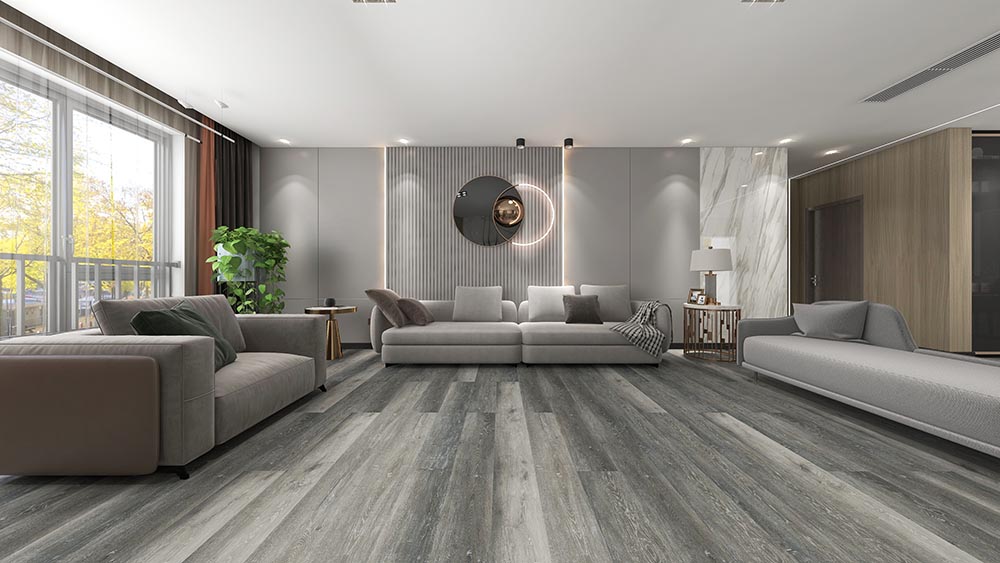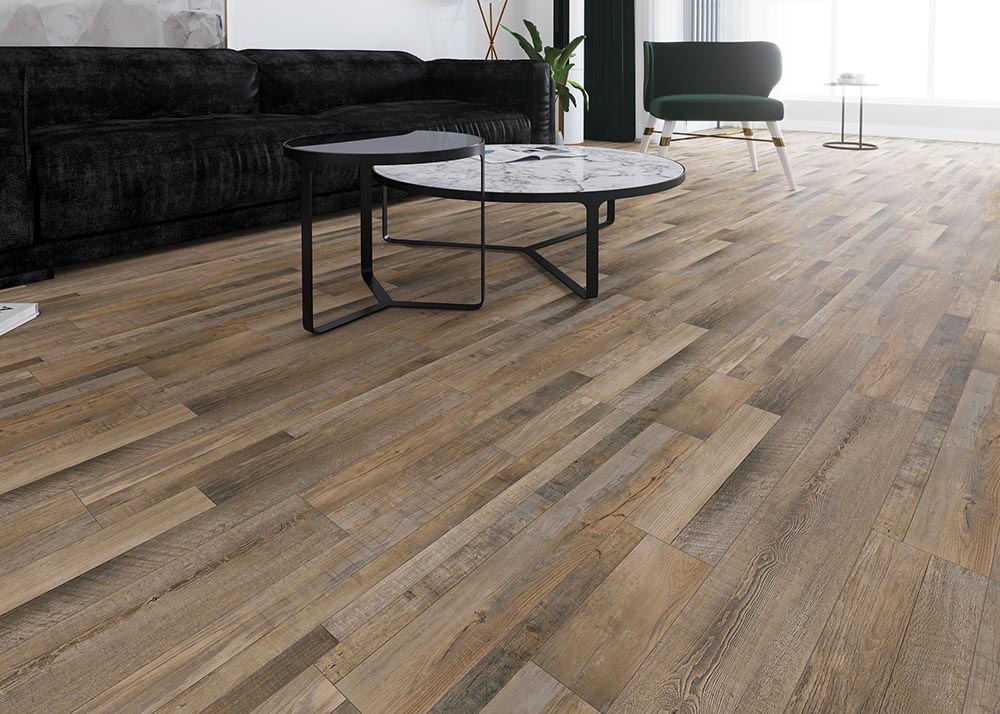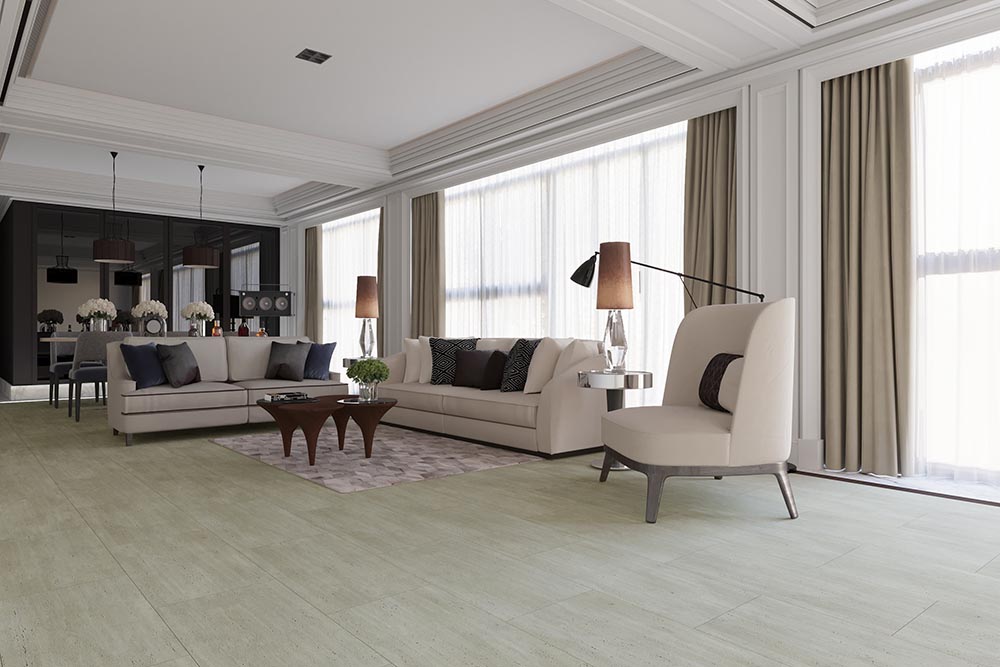Walk into a home in Texas, and you might find rich, espresso-stained SPC planks mimicking hardwood. Step into a Parisian apartment, and chances are you’ll see sleek, light-gray stone-look SPC. In Tokyo? Minimalist, wide-plank SPC in pale oak tones. SPC flooring‘s design isn’t just about durability—it’s a reflection of culture, climate, and lifestyle. Let’s dive into how regional tastes shape the colors, textures, and patterns that dominate SPC trends around the globe.
North America: Warm Woods and Bold Character
In the U.S. and Canada, SPC design leans into comfort and familiarity. Hardwood has long been a status symbol, so it’s no surprise that 70% of North American SPC sales are wood-look planks (per 2024 industry reports). But it’s not just any wood—regional nuances matter:
The South (Texas, Georgia): Loves deep, reddish-brown tones (think hickory or Brazilian cherry) that pair with traditional decor and warm, sunny interiors. Wide planks (7-9 inches) are popular here, adding a sense of spaciousness to ranch-style homes.
The Northeast (New England): Prefers cooler wood tones—ash, maple, or white oak—with subtle grain patterns. These complement the region’s historic homes and neutral, layered interiors (think wool rugs and linen sofas).
The West Coast (California, Oregon): Embraces “weathered” or “reclaimed” wood looks. Gray-washed oak or driftwood-inspired SPC fits the laid-back, beachy vibe, often paired with open-concept spaces and large windows.
A key trend across North America? Matte finishes. Glossy floors feel outdated; instead, homeowners want low-sheen surfaces that hide scratches (perfect for kids and pets) while adding a modern, understated elegance.
Europe: Sleek Stones and Minimalist Hues
Europeans treat flooring as a canvas for minimalist design, and SPC’s versatility shines here. Stone-look patterns dominate, but the “why” varies by region:
Mediterranean (Italy, Spain): Draws inspiration from local landscapes. SPC that mimics travertine (with its warm, beige tones and subtle veining) or terracotta (rustic, earthy reds) is everywhere. These pair with terracotta roof tiles, white walls, and indoor-outdoor living spaces.
Northern Europe (Sweden, Denmark): Favors cool, pale stones—think Carrara marble or limestone in white, gray, or soft blue. These brighten dark winters and align with the “hygge” aesthetic, complementing light woods, neutral textiles, and minimalist furniture.
Western Europe (France, Germany): Mixes stone and wood looks. Parisian apartments often opt for gray stone-look SPC in small, herringbone patterns (a nod to classic parquet), while Berlin lofts lean into wide-plank, black slate-inspired SPC for an industrial edge.
Texture is key in Europe. Unlike North America’s love for smooth finishes, European SPC often features “embossed-in-register” (EIR) textures, where the pattern’s grain or veining matches the surface feel—so a stone-look plank actually feels like stone underfoot.
Asia: Light Woods and Compact Elegance
In densely populated Asian cities, SPC design balances style with practicality—especially in small spaces.
Japan: Prioritizes “ma” (negative space) and simplicity. Pale, blonde woods (like Japanese cypress or white ash) in narrow planks (4-6 inches) create a sense of calm. Matte, water-resistant SPC is a must here, as many homes use traditional tatami mats alongside Western-style furniture.
South Korea: Loves “natural modern” designs. Light oak or birch-look SPC with subtle, straight grain pairs with clean-lined sofas and built-in cabinetry. Gray undertones are popular, adding a sleek touch without feeling cold.
Southeast Asia (Singapore, Thailand): Focuses on coolness—literally. Darker wood tones (walnut or teak) or marble-look SPC (white with gray veining) help rooms feel cooler in humid climates. Glossy finishes are more common here than in the West, as they reflect light and make small spaces feel larger.
A unique trend? Custom patterns. In Japan, some brands offer SPC with subtle geometric motifs (inspired by traditional kumiko woodwork), while in South Korea, “live-edge” SPC planks (mimicking the natural, uneven edge of real wood) add organic warmth to modern homes.
Why These Differences Matter (For Homeowners and Brands)
Understanding regional tastes isn’t just for designers—it helps homeowners make choices that fit their lifestyle. A Texan might prioritize scratch resistance and bold color, while a Parisian values texture and light-reflecting properties. For brands, it’s about localization: a company selling SPC in Italy will emphasize stone patterns and EIR textures, while one targeting California will highlight weathered wood looks and matte finishes.
But here’s the beauty of SPC: it’s adaptable. Whether you’re in Texas dreaming of a European stone floor or in Tokyo craving a West Coast driftwood vibe, there’s an SPC design to bridge the gap.
Post time: Sep-22-2025




